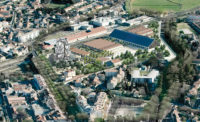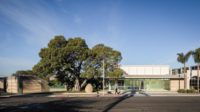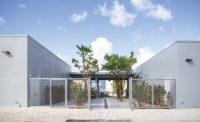Mwabwindo School by Selldorf Architects
Zambia

Students play soccer outside their new school in the Zambian village of Mwabwindo. Their uniforms were made by Studio One Eighty Nine, a social enterprise in Ghana founded by marketing executive Abrima Erwiah and actor Rosario Dawson.
Photo © Chosa Mweemba, courtesy Selldorf Architects

The flat, open site inspired the architect’s design of the shaded steel structure.
Photo © YAK Films

A raised corrugated-metal roof floats above the classrooms and courtyards, its generous openings admitting abundant daylight and fresh air everywhere.
Photo © Chosa Mweemba, courtesy Selldorf Architects

A raised corrugated-metal roof floats above the classrooms and courtyards, its generous openings admitting abundant daylight and fresh air everywhere.
Photo © Chosa Mweemba, courtesy Selldorf Architects

Local masons used 150,000 handmade bricks to create a lattice pattern in some walls.
Photo © Chosa Mweemba, courtesy Selldorf Architects

Classrooms have plaster walls, poured concrete floors, and Mukwa wood doors.
Photo © Chosa Mweemba, courtesy Selldorf Architects

Image courtesy Selldorf Architects







Architects & Firms
When Joseph Mizzi asked the architect Annabelle Selldorf if she would consider designing a primary school in rural Zambia pro bono for his nonprofit, the 14+ Foundation, she remembers replying, “Hello? Yes, obviously!” The response from her New York office was equally enthusiastic. “The need and desire to do something that changes the paradigm was on everyone’s mind,” she says.
Additional Content:
Jump to credits & specifications
Largely designed at the Manhattan architecture studio of Selldorf's eponymous firm and managed on the ground by 14+, the Mwabwindo School—which opened in May—serves around 250 students from preschool through 7th grade, with a curriculum supplemented by arts- and Montessori-based programs. Located seven miles from 14+’s first project in Zambia, the Chipakata Children’s Academy, Mwabwindo is reducing the overcrowding at two nearby government schools.
To respond to the local climate—intensely hot and dry except in the rainy season, from November to April—Selldorf and her team devised a 23-by-23-foot grid, covered by a corrugated-metal roof canopy supported by a steel superstructure. Underneath this giant shade tent, inspired by the trees dotting the Central African Plateau, the architect placed five classroom and administration buildings, made from mud bricks fabricated on-site by local masons. The classroom buildings are arranged around courtyards and an internal “street.” A covered assembly area allows the entire school and larger community to gather for meals, performances, and other occasions. Here, the corrugated roof is slightly higher, signifying the entrance to the school. A bar-shaped building to the east of the classrooms contains storage and a kitchen. To the north are a soccer field, community gardens, and a cluster of six housing units for teachers.
The steel shade structure, designed by Silman engineer Nat Oppenheimer, was built first, shielding workers during the rainy season while the classrooms were constructed beneath it. “The shade tent wanted to be as light and plain as possible,” says Selldorf. “It wasn’t meant to be an attention-grabbing gesture.” Its beauty is in its seemingly weightless elevation, and its connection to thin shade structures seen in almost every culture, including the wood barns of the American west.
A lattice pattern in some of the brick walls allows daylight to penetrate and air to circulate, as do operable clerestory classroom windows. Mwabwindo is off the electrical grid and uses 100 percent renewable energy, including solar panels, and a windmill to pump well water. Toilets are dry composting.
Mizzi, the president of Sciame Construction, founded 14+ with Nchimunya Wulf in 2012 after a trip as a volunteer for World Bicycle Relief to landlocked Zambia. There he learned that children were walking up to nine miles a day to get to school, and he returned to the States inspired to use his connections in the architecture, engineering, and construction professions to create better access to education, health care, and local services. Chipakata Children’s Academy opened in 2015, a pro bono design by Susan Rodriguez, then a partner and design principal at New York–based Ennead Architects, Frank Lupo, and Randy Antonia Lott. Chipakata now serves 250 primary school children.
Mwabwindo School completes an educational network that includes more than 20 staff members between the two institutions. “Our schools now allow students to walk much shorter distances, which is central to the founding mission,” says Mizzi. Chipakata was the Foundation’s “three-dimensional business card,” he adds, establishing trust, along with the peripheral projects Mizzi’s team built in the area—roads and a grinding mill, for example. He sees the success of a rural school as intimately tied to the health and vitality of the larger community. “The one obvious new idea that came out of our experiences at Chipakata is the integration of a dormitory building for grade eight and nine students, starting with the girls,” says Mizzi. “We believe this will improve and help stabilize their learning environment.” To that end, Selldorf—who visited the site during construction—is now designing student housing for Mwabwindo.
While the school is one of Selldorf’s most remote projects, the design process solidified the architect’s thinking about the importance of good architecture in education everywhere. “In some ways, I wish I could do a school like that here in a America,” she says. “The conditions and circumstances may be a little different, but the thinking should be the same—the experience of daylight and designing for seasonal change. The quality of the architecture will help inspire kids and make them feel safer and more welcome. It reminded me why I wanted to be an architect.”
CreditsArchitect: Selldorf Architects 860 Broadway, 2nd Fl New York, NY 10003 212.219.9571
Personnel in architect's firm who should receive special credit: Principal: Annabelle Selldorf, FAIA Partner-in-charge: Sara Lopergolo, AIA Project Manager(s): Oliver Link, RA; John Spencer Project Architect: David Bench Project Team: Michael Baskett, Laura Bown, Ger Brennen, Jonathan Chesley Dionisio Cortes-Ortega, Jeanie Fan, Sondra Fein, Mary Hohlt, James Jarzyniecki, Jaehyun Lee, Kristine Makwinski, Jonathan Pohl, Zachary Rousou, Cillian Sheehan, Molly White Engineers: Structural: Silman; Nat Oppenheimer Daylighting: Renfro Design Group, Richard Renfro, Jenny Stafford Director of Design and Construction: Fabian Bedolla
Photographer: Chosa Mweemba |
SpecificationsStructural System Painted Steel
Exterior Cladding Red Brick Handmade on Site
Roofing Painted Corrugated Metal
Windows Metal Windows: Amalgamated
Interior Finishes Floors: Concrete
Energy Solar: Davis & Shirtliff |














